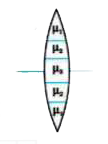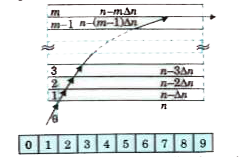Complete Solutions to OBJECTIVE TYPE QUESTIONS (INTEGER TYPE QUESTIONS) of chapter RAY OPTICS AND OPTICAL INSTRUMENTS of Class 12 book with complete answers and questions
| Class 12 | PHYSICS |
| Chapter | RAY OPTICS AND OPTICAL INSTRUMENTS |
| MODERN PUBLICATION | OBJECTIVE TYPE QUESTIONS (INTEGER TYPE QUESTIONS) |
| Number Of Questions | 13 |
| Academic Year | 2023-24 |
There is a concave mirror of focal length f and an object of length 2.5 cm is placed at a distance 1.5 f from concave mirror. Length of the object is perpendicular to the principal axis. What is the length of image in cm ?
`|{:(0,1,2,3,4,5,6,7,8,9):}|`
View SolutionWhen some object is kept at a distances `u_(1) and u_(2)` from the concave mirror then size of images are found to be same. If magnitude of focal length can be written as `( u_(1)+ u_(2))//n`, then what will be the value of n ?
`|{:(0,1,2,3,4,5,6,7,8,9):}|`
View SolutionA layer of oil 3 cm thick is floating on a layer of coloured water 5 cm thick. Refractive index of coloured water is `5//3` and the apparent depth of the two liquids appears to be `36//7`cm. Find the refractive index of oil.
View SolutionMagnification of simple microscope is found to be 3 when image is formed at least distance for clear vision. What will be the magnification of simple microscope when final image is formed at infinity ?
`|{:(0,1,2,3,4,5,6,7,8,9):}|`
View SolutionR is the radius of curvature for both the surfaces of lens shown in figure. Refractive index `mu_(1), mu_(2) and mu_(3)` are indicated in the figure. Light rays are incident from the side of refractive index `mu_(1)` as shown. If f is focal length of lens then find `f//R` for ` mu_(1) = 1, mu_(2)= 1.5, mu_(3)= 2`.
`|{:(0,1,2,3,4,5,6,7,8,9):}|`
View SolutionA person wants to use `+20 D` lens as simple microscope. If the person uses `+1.5 D` glasses to have normal vision from 25cm onwards. What maximum magnification can the person achieve if he uses microscope without the glasses ?
`|{:(0,1,2,3,4,5,6,7,8,9):}|`
View SolutionSunlight of intensity `1.3kW m^(–2)` is incident normally on a thin convex lens of focal length 20 cm. Ignore the energy loss of light due to the lens and assume that the lens aperture size is much smaller than its focal length. The average intensity of light, in kW `m^(–2)`, at a distance 22 cm from the lens on the other side is __________.
View SolutionThere is a concave mirror of radius of curvature 20cm. A point object is placed at distance 15cm from the mirror. If point object start moving with speed `2mm//s` perpendicular to principal axis then at this instant what will be the speed of image in `mm//s` ?
`|{:(0,1,2,3,4,5,6,7,8,9):}|`
View SolutionA convex lens is made of three different materials which are symmetrically distributed as shown in figure.
If some point object is placed on its principal axis then what will be the number of images formed ?


View SolutionA prism is shown in the figure with prism angle `75^(@)` and refractive index `sqrt(3)`. A light ray incidents on a surface at incident angle `theta`. Other face is coated with a medium of refractive index n. for ` theta le 60^(@)` ray suffers total internal reflection find value of `n^(2)`.
_PHY_E01_011_Q01.png)
View SolutionConsider a concave mirror and a convex lens (refractive index 1.5) of focal length `10 cm` each separated by a distance of `50 cm` in air (refractive index = 1) as shown in the Fig. An object is placed at a distance of `15 cm` from the mirror. Its erect image formed by this combination has magnification `M_1`. When this set up is kept in a medium of refractive index `7//6`, the magnification becomes `M_2`. The magnitude `((M_2)/(M_1))` is :
 .
.
View SolutionA monochromatic beam of light is incident at `60^@` on one face of an equilateral prism of refractive inder `n` and emerges from the opposite face making an angle `theta` with the normal. For `n = sqrt(3)`, the value of `theta` is `60^@ and (d theta)/(dn) = m`. The value of `m` is.
View SolutionA monochromatic light is travelling in a medium of refractive index n = 1.6. It enters a stack of glass layers from the bottom side at an angle `theta = 30^(@)`. The interfaces of the glass layers are parallel to each other. The refractive indices of different glass layers are monotonically decreasing as `n_(m)=nmDeltan`, where `n_(m)` is the refractive index of the `m^(th)` slab and `Deltan` = 0.1 (see the figure). The ray is refracted out parallel to the interface between the `(m – 1)^(th)` and `m^(th)` slabs from the right side of the stack. What is the value of m ?

View Solution
OBJECTIVE TYPE QUESTIONS (INTEGER TYPE QUESTIONS) questions and complete solutions for chapter RAY OPTICS AND OPTICAL INSTRUMENTS of MODERN PUBLISHERS PHYSICS (HINGLISH) of Class 12
All Exercises from MODERN PUBLICATION Class 12 PHYSICS RAY OPTICS AND OPTICAL INSTRUMENTS
- CHAPTER PRACTICE TEST
- Conceptual Questions
- Higher Order Thinking Skills & Advanced Level (QUESTIONS WITH ANSWERS)
- NCERT (EXemplar Problems Obejective Questions) (Multiple Choice Questions (Type-I)
- NCERT (EXemplar Problems Obejective Questions) (Multiple Choice Questions (Type-II)
- NCERT (Exemplar Problems Subjective Questions) (Very Short Answer Type Questions)
- NCERT FILE SOLVED (TEXT BOOK EXERCISES)
- OBJECTIVE TYPE QUESTIONS (A. MULTIPLE CHOICE QUESTIONS)
- OBJECTIVE TYPE QUESTIONS (ASSERTION REASON TYPE QUESTIONS)
- OBJECTIVE TYPE QUESTIONS (B. MULTIPLE CHOICE QUESTIONS)
- OBJECTIVE TYPE QUESTIONS (C. MULTIPLE CHOICE QUESTIONS)
- OBJECTIVE TYPE QUESTIONS (D. MULTIPLE CHOICE QUESTIONS)
- OBJECTIVE TYPE QUESTIONS (INTEGER TYPE QUESTIONS)
- OBJECTIVE TYPE QUESTIONS (JEE (ADVANCED) FOR IIT ENTRANCE)
- OBJECTIVE TYPE QUESTIONS (JEE (MAIN) & OTHER STATE BOARDS FOR ENGINEERING ENTRANCE)
- OBJECTIVE TYPE QUESTIONS (MATCHING TYPE QUESTIONS)
- OBJECTIVE TYPE QUESTIONS (MATRIX MATCH TYPE QUESTIONS)
- PRACTICE PROBLEMS (1)
- PRACTICE PROBLEMS (10)
- PRACTICE PROBLEMS (11)
- PRACTICE PROBLEMS (2)
- PRACTICE PROBLEMS (3)
- PRACTICE PROBLEMS (4)
- PRACTICE PROBLEMS (5)
- PRACTICE PROBLEMS (6)
- PRACTICE PROBLEMS (7)
- PRACTICE PROBLEMS (8)
- PRACTICE PROBLEMS (9)
- Revision Exercises (Additional Questions)
- Revision Exercises (Fill in the Blanks)
- Revision Exercises (Long Answer Questions)
- Revision Exercises (Numerical Problems)
- Revision Exercises (Short Answer Questions)
- Revision Exercises (Very Short Answer Questions)
- SOLVED EXAMPLES
- Tough & Tricky (PROBLEMS)